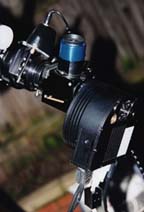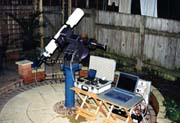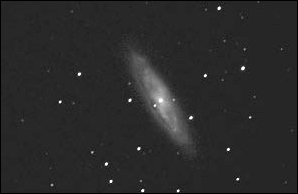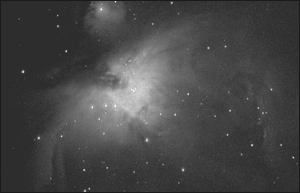CCD Imaging
The development of
the CCD camera has done incredible things for both professional
and amateur astronomy. It is now possible for the amateur to obtain
images using relatively small aperture which are comparable to
observatory class images taken many years ago. The ability to
go to even lower magnitudes, and the non reciprocity behavior
of ccds has meant that even short exposures can produce images
with a wealth of detail and information. As well as the pictorial
and aesthetic nature of the results, serious applications such
as Supernova hunting and Photometry can now be carried out with
modest - though not inexpensive equipment.
Various manufactures
produce a wide range of systems. Names such as SBIG, Apogee, and Starlight Xpress, are
common to most amateurs out there. There is however other smaller
companies working on less expensive equipment who also deserve
a mention such as Rockingham Instruments in the UK, and of course
there is the build it yourself Cookbook Camera for the braver
of us - I mean you!
I do not intend to
go into the details of the what's and wherefore's of CCDS, focal
lengths, pixel sizes, because I will probably get it wrong. Suffice
it to say, it is worth checking with the experts out there to
ensure that you can marry your scope to your camera. Warning there
are many experts out there! I have found members of the UK CCD
imaging Group very helpful in the past.
My initial foray into
CCD imaging was with a SBIG ST-7E this is only a small chip, but
also has small pixels ideal for my Takahashi FS128. It had a built
in guiding chip so helping a beginner like myself. This is not
a cheap instrument, but comes with the option of upgrading to
a larger chip, and the possibility of adding a colour filter wheel,
and adaptive optics for when I manage a longer focal length instrument.
Assuming I can learn how to use this one.
 ...
... ...
...  With the above setup
- St-7E and my Takahashi FS128 and my Sony laptop. I started to
try my hand at imaging. I had a few problems at first, but slowly
I got the hang of it. Here are images of my first Galaxy M65,
and my first Nebulae M42
With the above setup
- St-7E and my Takahashi FS128 and my Sony laptop. I started to
try my hand at imaging. I had a few problems at first, but slowly
I got the hang of it. Here are images of my first Galaxy M65,
and my first Nebulae M42
 .....
..... Unfortunately during
the following weeks I had problems with my mount, and also problems
with finding a dry spell in which to fix/test it. This created
a massive delay in my observing whilst I sent my mounts electronics
back to the US. It turned out to be the hand set - though I am
still sceptical to be honest. Having got the mount up and running
I then had to dismantle to raise the height of the pier for the
Astrophysics 6" f12 refractor - more delay. Having decided
to sell the AP, and get the AP900 GTO mount, I sold the ST-7E
to help finance this. Bored yet? Intending to upgrade the CCD
camera to a larger chip, and also one which would be more suited
to both my Takahashi refractors, and my C11.
My choice was to stick
to SBIG and I have upgraded to the ST10E, this is of considerable
increase in chip size, with fine 6.8 um pixels, which can be binned
to get to 24 um for the longer focal length C11. Full details
appear on the SBIG site so I won't repeat them here. Again it
comes with a separate guiding chip, and options for the adaptive
optics, and evidently an autofocus system to follow - now that
would be a help. I have used similar in microscopy before so it's
nice to see it moving to our domain.
For the SBIG ST-10E and Imaging Page Follow this link
Astronomical Image Enhancement & Processing
Astronomy
Main............ Home
Unfortunately during
the following weeks I had problems with my mount, and also problems
with finding a dry spell in which to fix/test it. This created
a massive delay in my observing whilst I sent my mounts electronics
back to the US. It turned out to be the hand set - though I am
still sceptical to be honest. Having got the mount up and running
I then had to dismantle to raise the height of the pier for the
Astrophysics 6" f12 refractor - more delay. Having decided
to sell the AP, and get the AP900 GTO mount, I sold the ST-7E
to help finance this. Bored yet? Intending to upgrade the CCD
camera to a larger chip, and also one which would be more suited
to both my Takahashi refractors, and my C11.
My choice was to stick
to SBIG and I have upgraded to the ST10E, this is of considerable
increase in chip size, with fine 6.8 um pixels, which can be binned
to get to 24 um for the longer focal length C11. Full details
appear on the SBIG site so I won't repeat them here. Again it
comes with a separate guiding chip, and options for the adaptive
optics, and evidently an autofocus system to follow - now that
would be a help. I have used similar in microscopy before so it's
nice to see it moving to our domain.
For the SBIG ST-10E and Imaging Page Follow this link
Astronomical Image Enhancement & Processing
Astronomy
Main............ Home